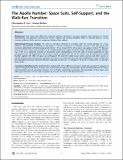The Apollo Number: Space Suits, Self-Support, and the Walk-Run Transition
Author(s)
Carr, Christopher E.; McGee, Jeremy
DownloadCarr-2009-The Apollo Number_ s.pdf (381.1Kb)
PUBLISHER_CC
Publisher with Creative Commons License
Creative Commons Attribution
Terms of use
Metadata
Show full item recordAbstract
Background: How space suits affect the preferred walk-run transition is an open question with relevance to human
biomechanics and planetary extravehicular activity. Walking and running energetics differ; in reduced gravity (,0.5 g),
running, unlike on Earth, uses less energy per distance than walking.
Methodology/Principal Findings: The walk-run transition (denoted *) correlates with the Froude Number (Fr = v2/gL,
velocity v, gravitational acceleration g, leg length L). Human unsuited Fr* is relatively constant (,0.5) with gravity but
increases substantially with decreasing gravity below ,0.4 g, rising to 0.9 in 1/6 g; space suits appear to lower Fr*. Because
of pressure forces, space suits partially (1 g) or completely (lunar-g) support their own weight. We define the Apollo Number
(Ap = Fr/M) as an expected invariant of locomotion under manipulations of M, the ratio of human-supported to total
transported mass. We hypothesize that for lunar suited conditions Ap* but not Fr* will be near 0.9, because the Apollo
Number captures the effect of space suit self-support. We used the Apollo Lunar Surface Journal and other sources to
identify 38 gait events during lunar exploration for which we could determine gait type (walk/lope/run) and calculate Ap.
We estimated the binary transition between walk/lope (0) and run (1), yielding Fr* (0.3660.11, mean695% CI) and Ap*
(0.6860.20).
Conclusions/Significance: The Apollo Number explains 60% of the difference between suited and unsuited Fr*, appears to
capture in large part the effects of space suits on the walk-run transition, and provides several testable predictions for space
suit locomotion and, of increasing relevance here on Earth, exoskeleton locomotion. The knowledge of how space suits
affect gait transitions can be used to optimize space suits for use on the Moon and Mars.
Date issued
2009-08Department
Massachusetts Institute of Technology. Department of Earth, Atmospheric, and Planetary SciencesJournal
PLoS ONE
Citation
Carr CE, McGee J (2009) The Apollo Number: Space Suits, Self-Support, and the Walk-Run Transition. PLoS ONE 4(8): e6614. doi:10.1371/
journal.pone.0006614
Version: Final published version
ISSN
1932-6203